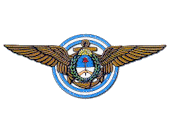Armada Argentina - Argentine Navy - Aviation
 Naval Aviation, as the fleet's air arm was called, was founded in 1921 when the first flying boats (seaplanes) and seaplane trainers were acquired by the Argentine Navy. By the mid-1980s the air arm consisted of some 3,000 personnel and counted in its inventory over 50 fixed-wing combat aircraft and at least 10 combat helicopters.
Naval Aviation, as the fleet's air arm was called, was founded in 1921 when the first flying boats (seaplanes) and seaplane trainers were acquired by the Argentine Navy. By the mid-1980s the air arm consisted of some 3,000 personnel and counted in its inventory over 50 fixed-wing combat aircraft and at least 10 combat helicopters.
The Argentina Navy, from the moment at which the man began to fly, as of 1860 in balloons, and 1903 in airplanes, felt a strong necessity to incorporate them to both to its operative activities. After the activities of the first pioneers, as of 1910 (Lieutenant of Frigate Melchor Escola), the creation of the Park and School of Aeroestación of Barragán Fort was ordered, in neighborhoods of the city of the Silver (1916), and the Division Aviation of organic way within its General Staff. In the decades of years 1930 and 1940 it participated in numerous exploratory flights of new routes (raids), along and to the wide thing of the Patagonia and of great rivers, and flew over all the extension of the Argentine Sea.
As of 1947, the Naval aviation was first in crossing the Antarctic Circle from the American continent, and in landing for the first time in the South Pole (1962). It participated in constant way, and contributing a generous price in lives, the development of the Naval Force with Aircraft carrier (of 1956 to 1968, the A.R.A. Independence, and from 1969 to 1988 the A.R.A. 25 of May), that distinguished to the Argentine Republic like the only South American nation that operated a ship of complexity of integral way.
The Air Naval Command, based at Puerto Belgrano. The following organizations report to this command:
- Air Naval Force No. 2, based at the Comandante Espora Air Naval Base. It concentrates combat and anti-submarine aircraft forming the Fleet's Air Naval Group.
- Air Naval Force No. 3, based at the Almirante Zar Air Naval Base, provided with Exploration and Sea Surveillance Squadrons, Electronic Surveillance and Mobile Logistical Support.
- The Naval Air Training Command and the Naval Aviation School based at the Punta Indio Naval Air Base; the Advanced Training and Attack Squadron and the Aerophotographical Group report to this organization.
Naval air operations were organized into six naval air wings during the early 1980s. The major shore bases from which these wings operated included the Punta del Indio Naval Air Base, the Comandante Espora Naval Air Base, the Almirante Irizar Naval Air Base, and the Ezeiza International Airport in Buenos Aires. Naval air operations were also carried out from facilities located at Puerto Belgrano in Buenos Aires Province; RIo Gallegos in Santa Cruz Province; and Ushuaia and Rio Grande, both in the National Territory of Tierra del Fuego; as well as from the aircraft carrier, the 25 de Mayo.
During the mid-1980s the navy's air fleet was organized into three attack squadrons — two equipped with a total of about 24 McDonnell Douglas A-4Q Skyhawks and the third, with 14 French-manufactured Dassault-Breguet Super Etendards. The Etendard aircraft were configured for firing the AM-39 Exocet air-to-surface antiship missile, the weapon that struck the British naval destroyer the Sheffield during the South Atlantic War.
It was believed that some of the Skyhawks were being fitted in the mid-1980s with the Israeli Gabriel III missiles, which were similar to the French Exocets. The Etendard squadron was hangared at the Comandante Espora Naval Air Base. Close to 30 Exocet missiles were estimated to be in Naval Aviation's inventory in early 1985.
Two squadrons equipped for carrying out maritime reconnaissance missions were based at Comandante Espora. One of the squadrons was composed of three Grumman S-2A and six S-2E Trackers that were often assigned for operations from the aircraft carrier. The second squadron was outfitted with seven to nine Lockheed L-188E Electras. A report published in mid- 1985 noted that at least two of the L-188s were being modified to carry out electronic intelligence missions.
In 1983 the naval air force's two helicopter squadrons were equipped with six Sikorsky SH-3D Sea Kings and were assigned an antisubmarine warfare role, as well as eight or nine Aérospatiale Alouette Ills and at least two of the Westland/ Aérospatiale-manufactured Sea Lynx. Another six Sea Lynx helicopters were on order at that time. The helicopters' shore command was at the Comandante Espora Naval Air Base, although most were permanently assigned to ships of the surface fleet.
Air transports used by the navy included approximately 15 aircraft that made up the general purpose squadrons assigned to various air bases. A special Antarctic squadron, based at Almirante Irizar, was equipped with three Pilatus PC-6 Turbo-Porters and one McDonnell Douglas C-45 transport. In early 1983 the first of some 45 Embraer EMB-325GB Xavante jets were said to have been purchased from Brazil to replace the light attack and training aircraft lost during the South Atlantic War.
In terms of naval-operational capability, a $65 million (peso) budget increase was decided in 2007 to address key material priorities. Also, as regards naval aviation’s tactical capacity, with the results rendered by the external audit, it became necessary to increase the Naval Aviation Command’s budget by $10 million pesos, to enable the organization to implement a repair program for detected failures. Along the same lines, the introduction of 4 helicopters offered by the US Navy was also anticipated.
|
NEWSLETTER
|
| Join the GlobalSecurity.org mailing list |
|
|
|

